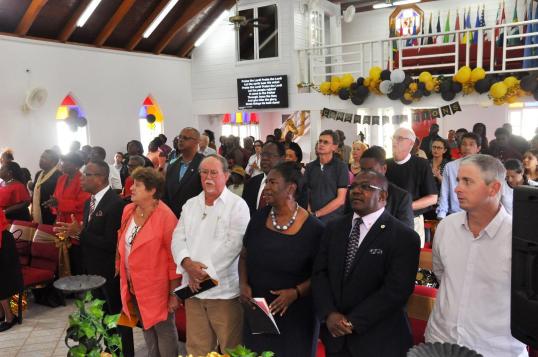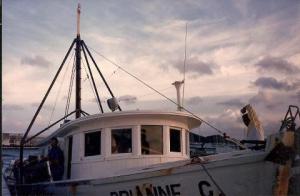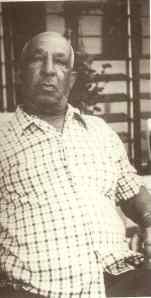The Life of George Seaman
The life of George Seaman
By Will Johnson
Flying over the Atlantic Ocean just east of the Wide Sargasso Sea, my dear old friend George Seaman came to mind. I was on my way to Amsterdam via Paris flying in style on Air France. I was flying this same route when he died some years ago.
George was a man of many talents which in the end boiled down to the love of writing, of the natural world and women. That everyone should be so lucky to get some of life’s greatest pleasures from these sources.
George was born on the island of Santa Cruz in 1904 when it was still a Danish possession. He insisted that it was some years later. His son George Jr. told me that his father had lied so much to the girls about his age that he actually believed his own lie.
George Sr.’s father was a citizen of the United States who had been a soldier for the North in the Civil War. George was the product of a late marriage of his father to a Danish lady and an only child from that union. He never really knew his father who also had a son by an earlier marriage in the United States.
Before continuing with my personal memories of George here are some excerpts of his life from his book “Every Shadow is a Man”.
Liz Wilson a friend of his has the following to say about the author.” George A. Seaman’s life has spanned almost the entire 20th Century. This true native of St. Croix in the U.S. Virgin Islands was born in the seaside village of Frederiksted in 1904 and his early childhood provided a rich preparation for his later years as ornithologist, explorer, naturalist, adventurer, poet, author and protector of wildlife.
However, it was at his stepfather John Dubois’ side that he learned how to fish and hunt and keenly observe plants, planets, stars, insects, birds, fish and the entire natural world around him.
This background prepared him for his first job at the American Museum of Natural History as a taxidermist and field collector which led to five expeditions in Central and South America and the Pacific.
He worked for Standard Oil in Venezuela and during World War II he conducted a successful search for wild rubber in Brazil to aid the Allies.
Returning to St. Croix in 1949 he was appointed Supervisor of Wildlife for the Virgin Islands, a position he held until his retirement in 1969.
Since that time, Seaman has used his years of environmental observation as the basis for his memoirs, his poetry, his poignant and often-times humorous yarns about birds, beasts, and humans. Throughout his books one eloquent thread prevails consistently – the need for tender stewardship and enlightened protection of his beloved island –St. Croix (Santa Cruz!).”
Ro Wauer has the following to say.
“Every Shadow Is a Man” truly provides insight into a different world than that which exists today. St. Croix during the first half of the twentieth century was a place of plenty, where a young man could enjoy the fruits of nature. The island contained an abundance of wildlife then; there was plenty of open space. George Seaman helps us to compare those “birds and times” with what we find today

George Seaman here posing with Mrs.Lynne Johnson-Renz and her mother Enid Renz-Holzhauser with Will Johnson in the background.
.
The value of George A. Seaman’s writings will undoubtedly only increase in time as St. Croix and the rest of the Virgin Islands continue to change. This book documents the status of several birds and their habitats that the author did not previously mention in his earlier nature writings: “Sticks from the Hawks Nest” in 1973; “Ay Ay: An Island Almanac” in 1980 and “Sadly Cries the Plover” in 1987. “Every Shadow Is a Man” is another very special contribution. The reader will find it of great value both for its natural history perspective and also for the pure enjoyment of exploring “back into birds and time.”
At an early age George became interested in nature. At the age of eighteen he shipped off to Panama where he joined an old schooner bound for the Pacific. He stayed for a year in the French Polynesian islands of Tahiti and the Marquesas. He was especially fascinated with the Marquesas. Later on he returned to Fredericksted to see his mother. After that he got employment with the Chiclet Company and also the ESSO. He was able to pursue his love and passion for nature by working in the jungles of Central and South America.
He explored the llanos of Venezuela and the mighty Amazon of Brazil.
In 1934 he visited Saba for the first time with “Tonce” Hassell whom he had met somewhere. Among my documents I have a copy of the Journal he kept while on Saba. Some of his observations on life here were remarkable for the time. He said that Saba was the only place where the children ruled the household. Fifty years later a person close to me observed the same thing. When she would go to pick up a four or five year old to go to Sunday school the parent would say: “He said he ain’t agoing today.”
Eric Lawaetz was also a good friend of George’s and came to see him on Saba before he died. Also Lito Vals of St.John also a writer and a mutual friend as well came to Saba to see George on occasion, as well as many other friends from his youth. George had moved to Saba in the 1960’s and had purchased a house in the area known as “Break Heart Hill” pronounced” Bracket Hill”. He remained here until his death in the l997
.
In his last years I would often visit him at the home he rented in English Quarter. He was drifting then. In his mind he was reliving old love affairs and bringing them up in between scientific discussions. While discussing the formation of planets the conversation would suddenly switch to a love affair on the Tapanahoni River. Just as quick he would return to explain me the mystery of how European and American eels both breed off Bermuda and yet an American eel has never been found in European waters and vice versa.
At a Christmas dinner I remember him regaling us with a Christmas dinner story of his own. He was traveling up the Amazon from Manaus to Iquitos. The cook stuck his head out of the kitchen door at the end of the meal and asked if he wanted dessert. Turns out the cook was a leper with half of his face gone and looked like death twice warmed over.
Everyone of course was grateful to George for that vivid description of his Christmas dinner on the Amazon. And of course there was lots of dessert left over.
Another story he told me when he was about 92 or so was about a Portuguese widow who ran a guesthouse somewhere in a remote village on the Amazon

I thought a lot about George and the stories he told me when I cruised down the mighty Amazon river.
.
George used to eat at her place. After months in the Jungle the widow looked more and more attractive. George finally convinced her to have a date. The widow was dead scared of losing reputation and so gave him specific instructions how to be careful in trying to gain access to her bedroom upstairs.

Good friends Elmer Linzey, Will Johnson, Jack Lincoln and George Seaman who often met for coffee and discuss world events.
On the appointed night George approached the staircase shoes in hand. The first step creaked terribly. The second step was worse and by the third step the ancient staircase decided to interrupt George’s plans and collapsed with a terrific bang. Everyone in the place started screaming and George was halfway to Peru by the time he stopped running. Several weeks later he decided to risk a visit back to the widow’s lodge. When she saw him she immediately approached him and said to him:” Thank God you didn’t come to the lodge that night. A robber came and the staircase collapsed and it was one mess. And he got away when he ran into the jungle.” I told George at the time that someday I was going to write a novel on his escapades entitled “How to catch a widow.”
When I was Senator I had lots of time on my hands and every day a group of us would meet at Scout’s Place. Besides George there was usually also Elmer Linzey, Walter Campbell, Harry Nietschman, Carl Anslyn and the occasional visitor to the island who would join us to hear our take on world affairs.
I cannot write all here. I am sure all of these friends; especially Elmer will be laughing when they read these memories in the great beyond. Sometime ago when I dreamt about him, Elmer that is, he was in a suit in a parking lot in a strange place. When he turned off he told me goodbye. I told my wife “I think Elmer has reached his destination.” But lo and behold on Aruba he visited me in a dream, which I cannot remember now. In Jorge Luis’ book “Everything and Nothing” he goes into the meaning of dreams and nightmares. He writes, “I have cited Sir Thomas Browne. He says that dreams give us an idea of the excellence of the soul, seeing the soul free of the body, and engaged in play and dreaming. He thinks that the soul enjoys its freedom.”
George’s first wife by whom he had two sons was a Sicilian woman whom he met in Santo Domingo. He was working there as a foreman at the time. I remember once at the bar at Scout’s Place. Carlyle Granger and I were listening to George’s stories with Diana Medero serving us our coffee from behind the bar
.
I changed my mind about telling this one. Santo Domingo and all of that you know. George’s stories usually implied subjects which only an experienced Calypsonian could think up. All I can say is that it had to do with the occupation by the United States army and how the rebels would entice soldiers on patrol to enter the cane fields with the same visions of Paradise as those of my friends in the Muslim world.
It is perhaps because of his many adventures that he decided to become a writer. As we all know writers see things differently from other people. They have a third eye.
I was on my way to Holland when I paid him his last visit in the hospital. We discussed the novel “One Hundred Years of Solitude” by Gabriel Garcia Marquez. He compared it to his years on Saba. I was secretly hoping that he would survive till I got back. Many times I had prepared his eulogy in my mind. Two other eulogies which I walked around with in my head were one for John William “Willie” Johnson my fathers’ cousin and one for my uncle Captain Charles Reuben Simmons. When they died I also happened each time to be in Holland on missions for the people of Saba.
George is buried in what was known as the “Potters Field” behind the War Monument in The Bottom. This was the site of the first church on Saba, the Presbyterian Church. Now along with George, Ernie West, Robert Beebe and others are buried there; it has gone from potters field to the “Ricoleta” of Saba. On my last visit to Buenos Aires I visited Ricoleta and the grave of Eva Peron who finally made it into the Duarte family tomb.
Little did the people of Saba know that it was a privilege to have had a man like George choose Saba as his home and last resting place.
He loved islands and was full of stories of island life. I remember him telling me of the time when he visited the island of Jost Van Dyke in the nineteen thirties. The lady who rented him a room gave him a whole heap of scrambled eggs for breakfast. And for lunch. And for dinner. The next morning after another scrambled egg experience, he looked out the window, and saw the lady cleaning a whole set of freshly caught fish. Upon enquiry she told him that she was preparing them for her lunch. “And what about me?” George asked. Surprised the lady said to him: “I was told that you Americans only ate scrambled eggs.”
He and the Canadian artist Bob Richards told me that they would like to have Charles Borromeo Hodge’s poem “Those Bouncing Beauties” inscribed on their tombstone’s. However when Borromeo published that poem on Women’s Day it caused such an uproar that I decided to send the poem to Mauritania instead where those bouncing beauties are a national obsession.
The Spanish poet Fray Luis de Leon wrote:
Vivir quiero conmigo
Gozar quiero del bien que debo al cielo,
A solas sin testigo
Libre de amor, de cello,
De odio, de esperanza, de recelo.
( I want to live with myself,/I want to enjoy the good that I owe to heaven,/alone, without witnesses,/free of love, of jealousy,/of hate, of hope, of fear.)
George came to Saba to live alone, without witnesses, free of love, of jealousy, of hate, of hope, of fear. It was not meant to be, even on Saba

I was in Holland when he was buried. I would have asked the new owners of his house to allow him to be buried in the private cemetery belong to famous sailor Tomma Johnson, which is located next to the house.
.
He is survived by his sons George on St. Croix and Johnny in Florida (and I am sure also a good number of love children in the Amazon, Venezuela and Costa Rica.)
As I travel the islands and see what has become of the natural beauty which George so much admired from his youth, I am reminded of Jeremiah l2. 10-11
“ Many shepherds have ravaged my vineyard
and trampled down my field, they have made my pleasant field a desolate wilderness,
made it a wasteland, waste and waterless, to my sorrow. The whole land is waste, and no one cares.”
So long George, your friend
Will











































































